Lock Blog
A resource for consumers, locksmiths, and security professionals
A resource for consumers, locksmiths, and security professionals
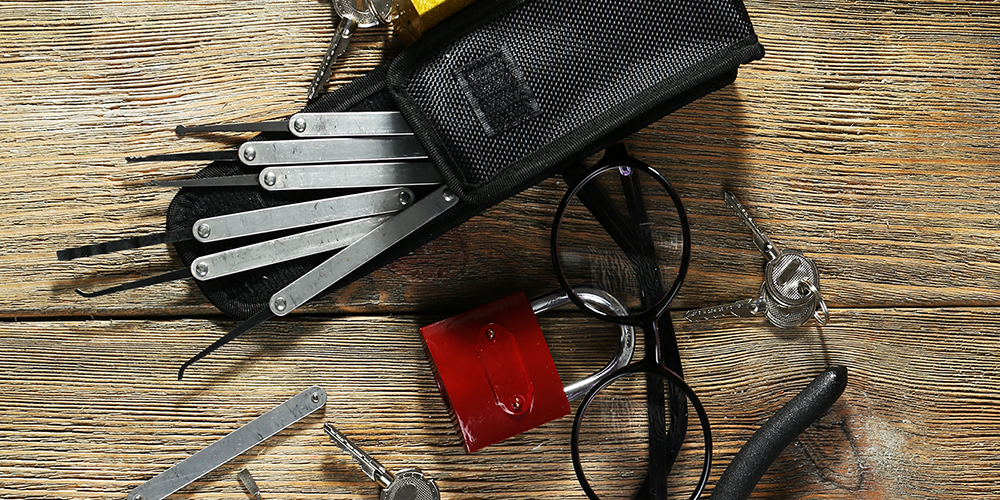
So you are tired of opening locks with paper clips and hairpins. You are looking for some more reliable tools and you want to cover your bases. There are 5 items that you are going to need in order to be prepared for most any lock picking situation. These are the bare essentials of the trade and will allow you semi-universal preparedness. This is a list for people that are interested in lockpicking as a hobby or becoming a professional locksmith. There are all kinds of great lock pick sets you can buy online, but most come with more types of picks than you will ever use. I am not sure what this really gives companies, but it does not give you (the picker) anything other than a headache. You should invest in more picks once you know what works best for you. When you can identify your problems with specific locks more accurately, it is at that point that you can begin to reassess you pick set. Something that is important to keep in mind, is that if you are working with European locks for whatever reason (perhaps you work in Europe), it is best to purchase all tools with a slimmer thickness. When buying your first pick set here is all you really need:
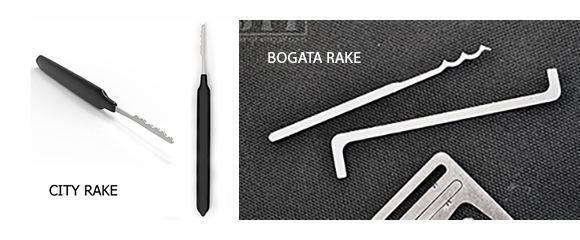
There are two types of rakes that are most popular. The first is called the City rake (L rake). The City rake looks like a saw blade, which gives it a similar look to a city’s silhouette. The saw blade shape of the instrument lends it to more toward a rocking motion (up and down in the keyway) because the rake is meant to simulate the bitting on the key. Perhaps the best rake (or most commonly used) is the Bogota. For raking, there is almost nothing better. There are some instances where the keyhole might not be large enough to accommodate it, but again this a list for your first lock pick set. As a beginner tool, there is nothing better than a Bogota. This rake is used the standard way, by moving the tool in and out of the keyhole quickly.
As a beginner tool, there is nothing better than a Bogota. This rake is used the standard way, by moving the tool in and out of the keyhole quickly. When you are buying a rake for European locks, try and not buy rakes that are too thin, because of the rough nature of their use. If a rake is too thin, it will break much easier. In the case of a lock with security pins, your rake may be used to get a false set. A false set means that your pins have gotten stuck on the shear line but have yet to clear it (the lock is still locked even though it seems as if you have set the pins). If there are security pins in the lock, your rake will not open it (unless you get very lucky). But you cannot count on luck, so you will need a few more tools so that you can single pin pick instead of raking.
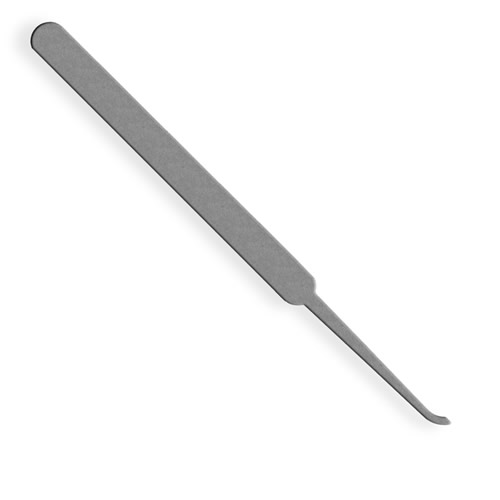
A hook is a great tool for single pin picking, but it has several other uses that make it very dynamic. How many uses you can get out of your particular hook will depend on the size of the hook as well as the size and shape of the keyway. A hook can be placed in a keyhole upside down (so that the trough is now its peak) and rocked as if it were an “L” rake. A hook can also be used to “bitch” pick a lock. Bitch picking (surely this term’s etymology does not stem from the derogatory use of this word) is when you begin to randomly pick the lock without any sense of what pins you are interacting with or how they are being set. Finally, there is the tried and true way of setting every single pin individually (single-pin picking or SPP). With all the versatility you get from having this one pick, it is no wonder it is such a mainstay in the locksmithing and lock picking industries.
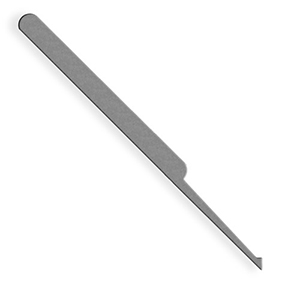
The half diamond is another adaptable tool whose scope will depend on the size of the keyhole and the size of tool’s tip. Like most every pick, the half diamond comes in a large, standard, and small size. Each size will vary slightly depending on what company you purchase from, but the standard size can be used effectively as a rake, the small is probably the most useful, and the large you might need to file down. The shape of the tool’s tip is a triangle. The slope on either side allows it to move past the pins and get underneath pins resting lower in the keyway.
The tapered edge also gives you the ability to move pins when you are applying a significant amount of tension on the lock. You can do this because the pins can be set by pressing the half diamond forward in a lock. With a hook, you would have to lever the device, which would require a significant amount of space that you may not have. This approach to setting the pins can also be adapted to zip the lock. Similar to raking, you can place the half diamond at the back of the keyway and pull it quickly out of the lock. Too large of a half diamond will not afford you any real advantages in most locks. Depending on the size it could be used as a rake, but most likely it will need to be modified.
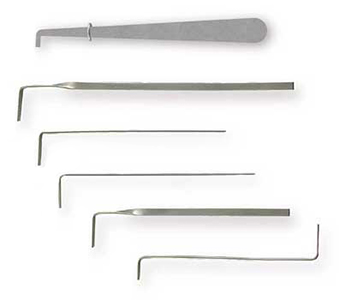
The tension wrench is the unsung hero of lockpicking. During all of these processes, and with all of these tools, you will need tension applied to the lock. The importance of tension cannot be stressed enough. If there is too much, the pins will not be able to set correctly, and the same will happen if there is not enough tension. These tools are the easiest to make on your own because at their most simple all they are is a piece of thin rectangular metal with a 90-degree bend on either side. For added effectiveness, you may wish to serrate the “L” of your tension wrench or purchase a tension wrench that is already serrated. This will allow for more grip in the keyway, which will secure the wrench and keep it from simply falling out. If your tension wrench falls out of the keyhole or tension is lost for another reason, you will need to reset and begin picking again.
You may also desire a twisted tension wrench, which will have a 90-degree twist right after the “L” bend. With a twisted tension wrench, it is easier to rest your finger on the wrench, and that ease will go a long way during a long picking session. Standard tension tools are used predominantly on the bottom of the keyway, but if the keyway is too short you will need a top of the keyway tension wrench. Some people will trim the “L” of a standard tension wrench and use it on the top of the keyway, but there is a specific top of the keyway tension tool. Top of the keyway tension wrenches have an “S” shape to them and are a single piece of flat metal. Once you begin to experiment with various and complicated locks it is important to refine these tools, or in some cases, make your own tension tool for that specific lock.

This item might sound obvious, but it is definitely something you need. It is also important when you are buying a case to get one that will serve your purposes. Cases are about practicality and functionality. You want a case that is going to fit the number of picks and tension wrenches that you would like to be caring. The case is going to need to have tight stitching and sturdy material that is not going to easily fall apart. Think about where this case is going to be on your person. If it is going to be in your back pocket there is no reason to get a case that will hold 30 picks. Because if you do put 30 picks in it, you are not going to want to sit down on it.
Make sure that the pockets and pouches are not too loose in the case, because you do not want your picks falling out. A top flap of some kind will prevent picks from falling when the case is flipped upside down and will save you a headache of picking up or losing your picks. You may want something that is larger than a back pocket tactical case. A larger case will allow you to have a complete set of tools so you are prepared for all types of locks, but it is important to not buy for your current collection. If you are investing in a larger case you should buy to grow. Chances are you will find tools that work better for you and need to have certain specialty tools, so your collection will always be growing.
These are the bare necessities of lock picking. There are definitely things that you can add, but if you are buying a lock pick set or building one yourself make sure you have these items. Your pick set will grow as you learn and begin to experiment with different types of locks. While you are learning take note of how you might want to refine your existing tools. The quality of the metal will influence your results and the longevity of the tool. Much like the process of buying locks, you are paying for quality. The more expensive the tool (for the most part) will reflect a higher quality of the steel, a better handle, etc. The thickness of your pick will also determine the number of uses it can have. Thinner is always best with European locks, but make sure that you are not sacrificing tensile strength unnecessarily. It is also important to know your local laws so that you are not acting illegally. Most states in the USA allow you own lock picks, but you must only use them on your own locks or on the locks of those that have given you explicit consent. Grow your skill, grow your love, and grow your collection.
Category: Buying Guides, Lock Picking, Tools of the Trade